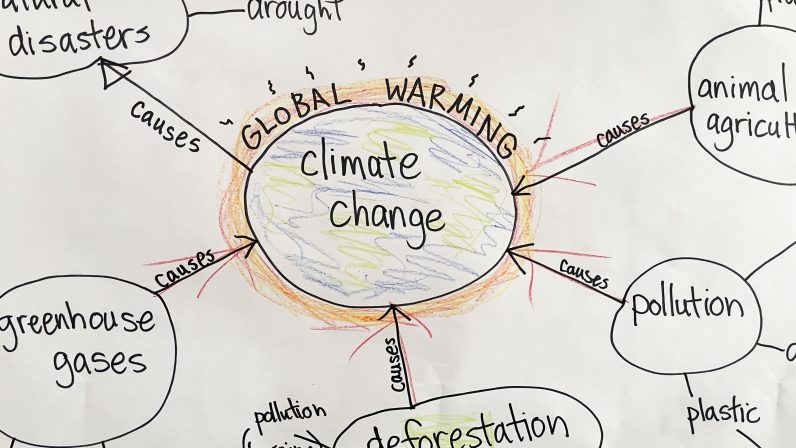Since I last wrote, my four-year run of avoiding Covid came to a screeching halt. Mostly it felt like a bad case of bronchitis, for which I am grateful. I’m slowly sifting through the residual symptoms, and am glad to be on this side of it. I now understand the brain fog piece, and see why the recovery time is so variable. It feels like a similar sifting process has been happening in my work with our elementary students this past week.
I went into it thinking we’d learn about young activists, and that’s how we started. It became clear, though, that before we could talk about activism, we needed to study issues that require activism. We watched a few videos, and each time climate change arose as the primary issue we should look at. Digging further, the teaching about global warming seemed to be a key step. My head was spinning with information, and I needed to visually sort it out. I ended up drawing a graph that showed the relationship between global warming and climate change, the causes and effects. I used the graph with both groups and it helped us all move forward.
We decided it would be good to narrow the work down to a few aspects of climate change with the first graders. In the coming weeks, they’ll collaborate in small groups to learn about either deforestation or pollution. By studying more tangible effects of climate change, hopefully we’ll be able to help them generate some tangible solutions in which they can participate.
The 2nd-4th graders looked at the graph and individually selected a focus area in which they were most interested. Their topics included: wildfires, flooding, rising sea levels, ocean plastic, and deforestation. Students have been assigned a classmate who is interested in the same topic. They will support each other in gathering information, looking at causes and effects, and generating solutions. In addition to composing a written document, they’ll create a project and make a team presentation to the class.
I look forward to modeling the process by learning more about specific topics not chosen by students. Currently, I’m curious about the disappearance of the Marshall Islands in the Pacific, due to rising the sea level. I’m also interested in ways to solve the ocean plastic problem. As with all emergent studies, I’m confident that we’ll learn from the surprises that arise from the type of collaboration that comes with this approach. And I know some passionate activists will be born along the way.

